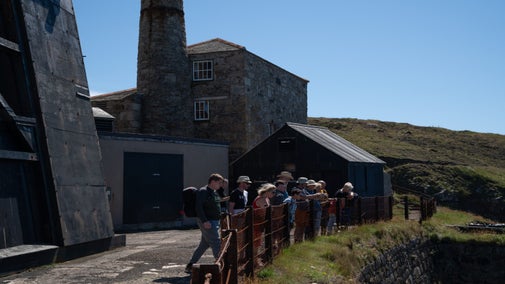1748
1748
Levant Mine first appeared on Martyn’s Map, as an amalgamation of three other early mines: Zawn Brinney, Boscregan and Wheal Unity. The location is remote but deposits of tin and copper were rich.

Discover more about tin and copper mining at Levant Mine and Beam Engine, part of the ‘Tin Coast’ and a UNESCO World Heritage Site. Find out the key dates of interest and how the mine gained great wealth, only to lose it when the price of tin dramatically dropped.
Copper and tin were mined at Levant for generations, and Levant was considered a ‘champion mine’ due to the abundance of both. Hazardous arsenic was also produced which is a by-product of tin ore.
The mine workings of Levant extend nearly a mile out under the seabed and over 600m below sea level. As technology improved in the 19th century, steam power allowed miners to go further and deeper under the sea.
Levant is the location of the oldest Cornish steam winding engine still working in its original location. Built by Harvey’s of Hayle in 1840 it is the last such engine still in steam in Cornwall. The beam engine stands inside the original Engine House where it wound up the ore from underground for 90 years.

Workers on the surface had a slightly healthier life than those below ground. Working outside was hard no matter what the weather. It was physically demanding work in all seasons, through the harsh summer sun or wild winter downpours.
Older women and girls worked on both the copper and tin dressing floors at Levant. Tasks were allocated according to strength and included breaking mineral into fist-sized sections using long-handled hammers. Levant was one of the few mines to continue to employ women as late as the First World War.
The word ‘bal’ in the Cornish language is ‘mine’. These bal maidens also took pieces to the stamps to be pulverised. The resulting material was then washed. Younger girls were employed to hand-sort through waste to pick out any pieces of tin or copper that had been missed.

Mining below the surface was dangerous work and working under the sea came with its own particular dangers. The temperature underground could reach upwards of 28°C. The heat and poor ventilation combined to make working conditions hazardous.
There was also the danger of rock fall from blasting the rock surfaces or being caught in the blast itself. The only light was from a tallow candle stuck to the miners’ helmets with clay.
Having survived the shift without mishap the Levant miner spent up to half an hour ascending the man engine – a mechanised method for miners to enter and exit the mine – to reach the ‘dry’ or changing room.
Prior to the installation of the man engine in 1857, the miners could spend at least an hour climbing to the surface via ladders once their shift was over. They would then face a long walk home, which could be several miles over rough cliff paths.
1748
Levant Mine first appeared on Martyn’s Map, as an amalgamation of three other early mines: Zawn Brinney, Boscregan and Wheal Unity. The location is remote but deposits of tin and copper were rich.

Find out when Levant Mine and Beam Engine is open, how to get here, the things to see and do and more.

Discover old mine buildings and a working steam-powered beam engine. See the wider natural landscape and wildlife that lives here.

Find out more about this Cornish tin mine on the Tin Coast near Levant. With parking and facilities it’s a great place to visit in combination with Levant.

Levant Mine and Beam Engine offers a variety of tours throughout the year. Access to Levant is by tour only so booking is advised.

Learn about people from the past, discover remarkable works of art and brush up on your knowledge of architecture and gardens.